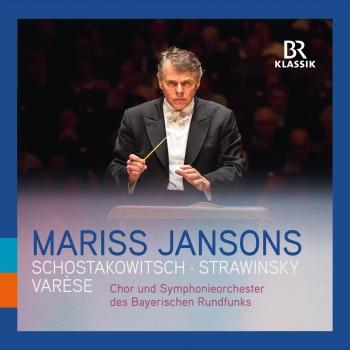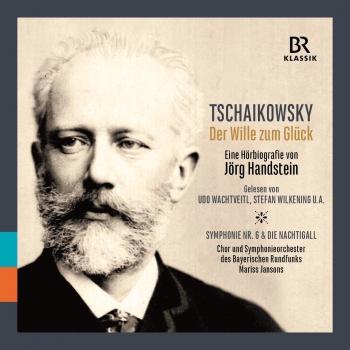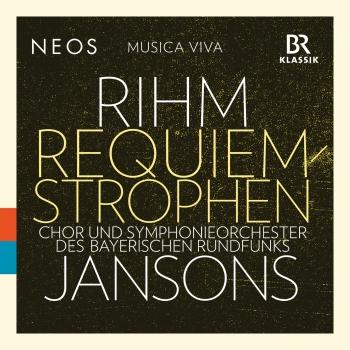
Album info
Album-Release:
2018
HRA-Release:
05.01.2018
Label: BR-Klassik
Genre: Classical
Subgenre: Vocal
Artist: Chor und Symphonieorchester des Bayerischen Rundfunks & Mariss Jansons
Composer: Joseph Haydn (1732–1809)
Album including Album cover Booklet (PDF)
- Franz Joseph Haydn (1732-1809): Mass in B-Flat Major, Hob. XXII:14 "Harmoniemesse":
- 1 I. Kyrie 07:07
- 2 II. Gloria 11:18
- 3 III. Credo 11:08
- 4 IV. Sanctus 02:52
- 5 V. Benedictus 04:14
- 6 VI. Agnus Dei 05:53
- Symphony No. 88 in G Major, Hob. I:88:
- 7 III. Menuetto. Allegretto - Trio 04:08
- Ludwig van Beethoven (1770-1827): Symphony No. 4 in B-Flat Major, Op. 60:
- 8 I. Adagio - Allegro vivace 11:10
- 9 II. Adagio 08:45
- 10 III. Menuetto. Allegro molto e vivace - Trio. Un poco meno allegro 05:45
- 11 IV. Allegro ma non troppo 07:01
- Johannes Brahms (1833-1897): Symphony No. 4 in E Minor, Op. 98:
- 12 I. Allegro non troppo 12:39
- 13 II. Andante moderato 10:54
- 14 III. Allegro giocoso 06:16
- 15 IV. Allegro energico e passionato 10:40
- Richard Strauss (1864-1949): Eine Alpensinfonie, Op. 64, TrV 233:
- 16 No. 1, Nacht 02:52
- 17 No. 2, Sonnenaufgang 01:25
- 18 No. 3, Der Anstieg 02:27
- 19 No. 4, Eintritt in den Wald 05:06
- 20 No. 5, Wanderung neben dem Bache 00:47
- 21 No. 6, Am Wasserfall 00:16
- 22 No. 7, Erscheinung 00:53
- 23 No. 8, Auf blumigen Wiesen 01:01
- 24 No. 9, Auf der Alm 02:22
- 25 No. 10, Durch Dickicht und Gestrüpp auf Irrwegen 01:42
- 26 No. 11, Auf dem Gletscher 01:15
- 27 No. 12, Gefahrvolle Augenblicke 01:34
- 28 No. 13, Auf dem Gipfel 04:56
- 29 No. 14, Vision 03:36
- 30 No. 15, Nebel steigen auf 00:20
- 31 No. 16, Die Sonne verdüstert sich allmählich 00:52
- 32 No. 17, Elegie 01:48
- 33 No. 18, Stille vor dem Sturm 02:54
- 34 No. 19, Gewitter und Sturm, Abstieg 04:22
- 35 No. 20, Sonnenuntergang 02:23
- 36 No. 21, Ausklang 06:06
- 37 No. 22, Nacht 02:02
- 38 No. 1, Frühling 03:24
- 39 No. 2, September 04:39
- 40 No. 3, Beim Schlafengehen 05:17
- 41 No. 4, Im Abendrot 08:09
- Gustav Mahler(1860-1911): Symphony No. 9 in D Major:
- 42 I. Andante comodo 28:01
- 43 II. Im Tempo eines gemächlichen Ländlers. Etwas täppisch und sehr derb 15:45
- 44 III. Rondo-Burleske. Allegro assai. Sehr trotzig 13:48
- 45 IV. Adagio. Sehr langsam und noch zurückhaltend 23:11
- Edgard Varèse (1883-1965):
- 46 Amériques (1922 Original Version) 28:38
- Igor Stravinsky (1882-1971): Symphony of Psalms:
- 47 I. Exaudi orationem meam 03:14
- 48 II. Expectans expectavi Dominum 06:14
- 49 III. Alleluja. Laudate Dominum 12:42
- Dmitri Shostakovich (1906-1975):
- 50 I. Largo 15:41
- 51 II. Allegro 06:21
- 52 III. Presto 07:44
Info for Portrait (Live)
“He’s the best of all of us!” In an interview about great conductors with the newspaper Die Welt on April 2, 2015, that was the remarkable response from Sir Simon Rattle when he was asked about Mariss Jansons. Numerous music fans the world over are in complete agreement with Rattle’s statement, and what better way to congratulate Mariss Jansons on his 75th birthday (the 14th of January, 2018)? The Maestro’s birthday was also the inspiration for this 5CD set from BR-KLASSIK.
Mariss Jansons played a decisive part in the decision by the Bayerische Rundfunk to establish a special CD label for its two orchestras and the Chor. As the chief conductor of the Concertgebouw Orchestra in Amsterdam, he had already appreciated the advantages of an orchestra having its own label: artistic freedom in deciding which musicians to collaborate with and which recordings to release, sovereignty over layout and design, reliable releases timed to coincide with international tours, and much more. By now, following his tenacious and therefore ultimately successful commitment to a new concert hall in Munich, the music world is certainly aware of the Maestro’s persistence, and not only where musical quality is concerned. So it was that in 2009, the Bayerischer Rundfunk released its first 9 CDs with recordings of the Chor and Symphonieorchester des Bayerischen Rundfunks and of the Munich Rundfunkorchester, on its new label BR-KLASSIK. The year 2017 saw the one hundredth production since that time – of Richard Strauss’ ‘An Alpine Symphony’ with the Symphonieorchester des Bayerischen Rundfunks conducted by Mariss Jansons.
(Stefan Piendl)
The CD box “Mariss Jansons – A Portrait”, newly released by BR-KLASSIK, contains a total of 5 CDs offering a representative cross-section of the classical symphonic repertoire – as well as a cross-section of the repertoire for which the chief conductor of the Symphonieorchester des Bayerischen Rundfunks has been highly praised again and again for his outstanding interpretative qualities.
Landmarks of great choral music can be found here, as well as milestones in symphonic development and select orchestral songs. The works range from music of the First Viennese School to early 20th-century Late Romanticism; from Haydn’s “Harmoniemesse” (with soloists Malin Hartelius, Michaela Knab, Judith Schmid, Christian Elsner, Bernhard Schneider, Franz-Josef Selig and the Chor des Bayerischen Rundfunks) to the Minuet from Haydn’s Symphony Hob. I:88; from Beethoven’s Fourth Symphony, Brahms’s Fourth Symphony and Mahler’s Ninth Symphony to Strauss’ Eine Alpensinfonie” op. 64, and also his “Vier letzte Lieder” (“Four Last Songs”, with the excellent soloist Anja Harteros). And the fifth CD offers several impressive masterpieces of the twentieth century including Stravinsky’s “Symphony of Psalms” (with the Chor des Bayerischen Rundfunks), ), Varèse’s symphonic poem “Amériques” – both recordings first time released on CD – and Shostakovich’s Sixth Symphony.
Malin Hartelius, soprano
Michaela Knab, soprano
Judith Schmid, alt
Christian Elsner, tenor
Bernhard Schneider, tenor
Franz-Josef Selig, bass
Chor des Bayerischen Rundfunks
Symphonieorchester des Bayerischen Rundfunks
Mariss Jansons, conductor
Symphonieorchester des Bayerischen Rundfunks
Soon after it was founded by Eugen Jochum in 1949, the Symphonieorchester des Bayerischen Rundfunks (BRSO) developed into an internationally renowned orchestra, its fame continuously expanded and fortified by its intensive touring activities. The orchestra owes its extraordinarily wide ranging repertoire and sound spectrum to the programme preferences of its previous chief conductors as well as to the great flexibility and solid stylistic security of each individual musician.
Fostering new music has an especially long tradition at the Symphonieorchester des Bayerischen Rundfunks with appearances in conjunction with the “musica viva” series, founded in 1945 by Karl Amadeus Hartmann, as one of the orchestra’s main assignments right from the start. At these concerts, Munich audiences have witnessed legendary performances of contemporary works at which the composers themselves generally stood on the podium of the orchestra. These included Igor Stravinsky, Darius Milhaud, Paul Hindemith, Bruno Maderna, Pierre Boulez, Hans Werner Henze, Witold Lutosławski, Krzysztof Penderecki, Cristóbal Halffter, Heinz Holliger, Hans Zender, Karlheinz Stockhausen, Mauricio Kagel, Luciano Berio as well as, more recently, Peter Eötvös.
The Symphonieorchester des Bayerischen Rundfunks was the only German orchestra with which Leonard Bernstein regularly collaborated for many years. In general, many renowned guest conductors, such as Clemens Krauss, Erich and Carlos Kleiber, Charles Munch, Ferenc Fricsay, Otto Klemperer, Karl Böhm, Günter Wand, Georg Solti, Carlo Maria Giulini, Kurt Sanderling, Wolfgang Sawallisch and Bernard Haitink have left indelible imprints on the Symphonieorchester in the past. Today, Riccardo Muti, Esa-Pekka Salonen, Franz Welser-Möst, Yannick Nézet-Séguin, Herbert Blomstedt, Daniel Harding and Robin Ticciati number amongst the significant partners who regularly mount the podium in Munich. For many years, the Symphonieorchester has also pursued approaches to early music and now collaborates regularly with such experts in historical performance practice as Thomas Hengelbrock, Ton Koopman and Giovanni Antonini.
Besides the many performances and recordings in Munich and other cities in the station’s broadcast range, extensive concert tours are central components in the everyday life of the orchestra today. Tours have taken the orchestra to virtually every European country, to Asia as well as to North and South America. It makes regular appearances in New York’s Carnegie Hall and in the renowned concert halls in Japan’s musical capitals. From 2004 to 2019, the Symphonieorchester was the orchestra in residence at the Easter Festival in Lucerne.
A further special feature is the encouragement of up-and-coming young musicians. In conjunction with the ARD International Music Competition, the Symphonieorchester accompanies young musicians both in the final rounds as well as in the symphonic closing concert featuring the prize winners. Since October of 2001 the Academy of the Symphonieorchester des Bayerischen Rundfunks has been doing valuable educational work by preparing young musicians for their later careers and thus building a solid bridge between education and professional activity. Beyond this, the Symphonieorchester maintains an encouragement programme for young people with many activities designed toward the worthy goal of bringing the younger generation closer together with classical music.
The history of the Symphonieorchester is closely intertwined with the names of its previous Chief Conductors, who were always concurrently Chief Conductors of the Chor des Bayerischen Rundfunks.
The founder, Eugen Jochum, led the orchestra for eleven years (from 1949 to 1960.) He built up the orchestra completely with top-grade musicians and established the orchestra’s worldwide reputation on its initial foreign tours. Munich audiences have him to thank for incomparable interpretations of Anton Bruckner’s symphonies. Besides Bruckner Eugen Jochum devoted special attention to the performance of sacred music, and also made regular appearances on the podium of musica viva.
Rafael Kubelík, who headed the orchestra for eighteen years (1961 to 1979), remained closely associated with the orchestra as a guest conductor until 1985. He expanded the repertoire to include works by Slavic composers like Smetana, Janáček and Dvořák, as well as spearheading the cause of 20th century composers such as Karl Amadeus Hartmann and conducting the first Mahler cycle with a German orchestra, which was then recorded. His impulsive, emotional approach to music won the hearts of all the musicians and made the Kubelík era one of the most fruitful ones in the history of the ensemble.
When his already designated successor Kyrill Kondrashin died unexpectedly in Amsterdam, the orchestra turned to Sir Colin Davis, thus gaining a recognized Berlioz specialist as chief conductor (1983 to 1992), who likewise proved an excellent advocate for the Viennese Classical Era as well as the works of English composers, especially Edward Elgar, Michael Tippett and Ralph Vaughan Williams.
From 1993 to 2002 Lorin Maazel led the Symphonieorchester. He set new styles of programming by performing cycles of symphonic works by Beethoven (1995 and 2000), Brahms (1998), Bruckner (1999) and Schubert (2001). He took his leave of his orchestra with a Mahler cycle in 2002.
A new and mutually pleasurable chapter in the history of the Symphonieorchester began in October of 2003 when the acknowledged favorite candidate of all the musicians, Mariss Jansons, assumed his post as the new Chief Conductor of the Chor and the Symphonieorchester des Bayerischen Rundfunks. In no time, he succeeded in creating an atmosphere of the highest artistic standards and a close emotional tie with the orchestra. He regularly received enthusiastic reviews both for his concerts in Munich and the many guest appearances in the leading musical capitals of Europe, America and Japan. Mariss Jansons placed particular emphasis on the works of Beethoven, Bruckner, Mahler, Strauss and Shostakovich. This era, which was particularly fulfilling and significant for both sides, ended with his death on December 1, 2019.
Mariss Jansons continued to expand the orchestra’s vast discography with a high number of CD releases. Completing his Shostakovich cycle with various major orchestras, the Symphonieorchester des Bayerischen Rundfunks contributed Symphonies Nos. 2, 3, 4, 12, 13 and 14. The recording of the 13th Symphony received a Grammy in the category of “Best Orchestral Performance.” Since 2009, the Symphonieorchester des Bayerischen Rundfunks has been releasing CD’s and DVD’s on Bavarian Broadcasting’s own label, BR-KLASSIK.
In a number of different surveys of music critics, the Symphonieorchester des Bayerischen Rundfunks has numbered among the top ten orchestras in the world, in the 2008 orchestra ranking by the British music magazine “Gramophone” (6th place) and in the Japanese music magazine “Mostly Classic” in 2010 (4th place).
The Symphonieorchester des Bayerischen Rundfunks got awarded the “Preis der Deutschen Schallplattenkritik” (Award of German Record’s Review) for Antonin Dvorak’s Symphony No. 9 conducted by Andris Nelsons. In February 2016, the production of the “Missa solemnis” by Ludwig van Beethoven under the direction of Bernard Haitink was nominated for the GRAMMY with choir and symphony orchestra of the Bayerischer Rundfunk. For the recording of the 3rd Symphony by Gustav Mahler under the direction of Bernard Haitink, the orchestra was awarded the BBC Music Award in April 2018. The recording of Bruckner’s Symphony No. 8, conducted by Mariss Jansons received the “Preis der Deutschen Schallplattenkritik” in 2018. Rachmaninoff’s “The Bells”, directed by Mariss Jansons, was awarded in April 2018 by the British “Gramophone Magazine” and the French magazine “Diapason d’Or”. The recording of Shostakovich’s Symphony No. 10 conducted by Mariss Jansons received the “Preis der Deutschen Schallplattenkritik” (Award of German Record’s Review) in 2020.
Mariss Jansons conducted his last concert with the BRSO on November 8, 2019 at the Carnegie Hall in New York. Just a few weeks later, on December 1, 2019, Mariss Jansons passed away in St. Petersburg at the age of 76.
On January 3, 2021, Sir Simon Rattle signed an initial five-year contract as the new Chief Conductor of the Symphonieorchester des Bayerischen Rundfunks and the Bavarian Radio Chorus beginning with the 2023/24 concert season. The conductor, who is appreciated worldwide for his artistic seriousness, compelling charisma, openness and versatility, made his debut with the BR Chorus and BRSO in 2010 with Schumann’s “Paradise and the Peri”. Right from the very beginning, Simon Rattle and the musicians of the BRSO have enjoyed an extraordinarily deep musical understanding, so that the musicians of both ensembles voted overwhelmingly in favor of Simon Rattle as their new chief conductor.
Booklet for Portrait (Live)












